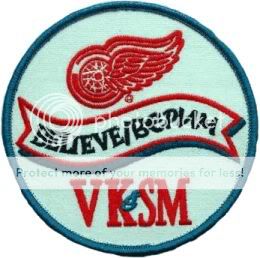There have been a wealth of personal stories published in the wake of Nicklas Lidstrom's retirement, and deservedly so. Some that stand out in my mind are Michael Petrella's
story published at The Production Line, Helene St. James'
account published in the Detroit Free Press, and George Malik's
post (along with a bunch of other great stories from around the internet) from The Malik Report. I wrote about my feelings on the retiring legend
here. It's clear that a great deal of what makes Nick so special is the impact he's had on people in and around the organization over the last 21 years.
There is, however, more to the story than, well, stories. Statistics help paint an additional portion of the picture, and below you'll find plenty of them. Enjoy.
1,564 career regular season games played
264 career regular season goals
878 career regular season assists
1,142 career regular season points
Plus 450 career +/- regular season
514 career penalty minutes
132 career powerplay goals
10 career shorthanded goals
35 career game-winning goals
3,875 career shots
6.8% career shooting percentage
27,790 regular season minutes played (NHL started recording
this in 1998-99 season)
26:54 average regular season TOI (since 98-99)
263 career playoff games played
54 career playoff goals
129 career playoff assists
183 career playoff points
Plus 61 career playoff +/-
76 career playoff penalty minutes
30 career playoff powerplay goals
3 career shorthanded playoff goals
11 career playoff game winning goals
656 career playoff shots
8.2% career playoff shooting percentage
4,475 playoff minutes played (since 98-99 season)
28:09 average playoff TOI (since 98-99)
31:10 average playoff TOI in 2001-02, a season in which Detroit played 23 playoff games and won the Stanley Cup, while Lidstrom won the Conn Smythe
1,827 total (reg season+playoffs) games played
318 total goals
1,007 total assists
1,325 total points
Plus 511 total +/-
162 total powerplay goals
13 total shorthanded goals
46 total game winning goals
4,531 total shots
32,265 total minutes played since 1998-99 season
20 seasons played
20 playoff appearances
6 Stanley Cup Finals appearances
4x Stanley Cup champion (97,98,02,08)
7x Norris Trophy winner (01,02,03,06,07,08,11)
11x Norris Trophy nominee (98,99,00,01,02,03,06,07,08,09,11)
0 Norris Trophy wins in first ten seasons
7 Norris Trophy wins in last ten seasons
6x Lady Byng nominee
1x Conn Smythe winner
1st European born player to win Norris Trophy
1st European born player to win Conn Smythe
1st European born player to captain a Stanley Cup
champion
1st Red Wings to win multiple Norris Trophies
10x first team All Star
2x second team All Star
2x All Star team captain (2000,2011)
4x Olympian
2006 Olympic Gold medal
1 Olympic Gold medal winning goal (2006)
2nd all-time games played as a Red Wing
9th in all-time Detroit franchise goals
3rd in all-time Detroit franchise assists
4th in all-time Detroit franchise points
1st in all-time Detroit franchise +/-…by +174
2nd in all-time Detroit franchise powerplay goals
7th in all-time Detroit franchise shorthanded
goals
8th in all-time Detroit franchise game-winning
goals
4th in all-time Detroit franchise game-tying
goals
6th in all-time Detroit franchise overtime goals
2nd in all-time Detroit franchise shots
11 all-time Detroit franchise leader categories in which Lidstrom is
in top 10 (12 are recorded on their website)
1 category in which Lidstrom is not a top-ten franchise
leader (penalty minutes)
Advanced stats
Hockey-reference.com uses an innovative point shares system
to evaluate approximately how many of a team’s point total from the season can
be directly attributed to a certain player. Explanation of the system here:
98.1 offensive point shares
113.6 defensive point shares
211.8 total point shares
37th all-time offensive point shares
3rd all-time defensive point shares
4th all-time total point shares
0.17 regular season goals/game
0.56 regular season assists/game
0.73 regular season points/game
Hockey Reference’s methodology for adjusting goals and assists is here:
Essentially, they’re attempting to see how goals and assists change if all past regular seasons were played under the conditions of the most recent regular season.
286 adjusted regular season goals
918 adjusted regular season assists
1,204 adjusted regular season points
20 seasons
1 uniform
1 city
1 number soon to be retired
Thanks, Nick.
Like it? Hate it? Let me know (and follow me) on Twitter @TOGBlog1 or by email at theoctopigarden@gmail.com


